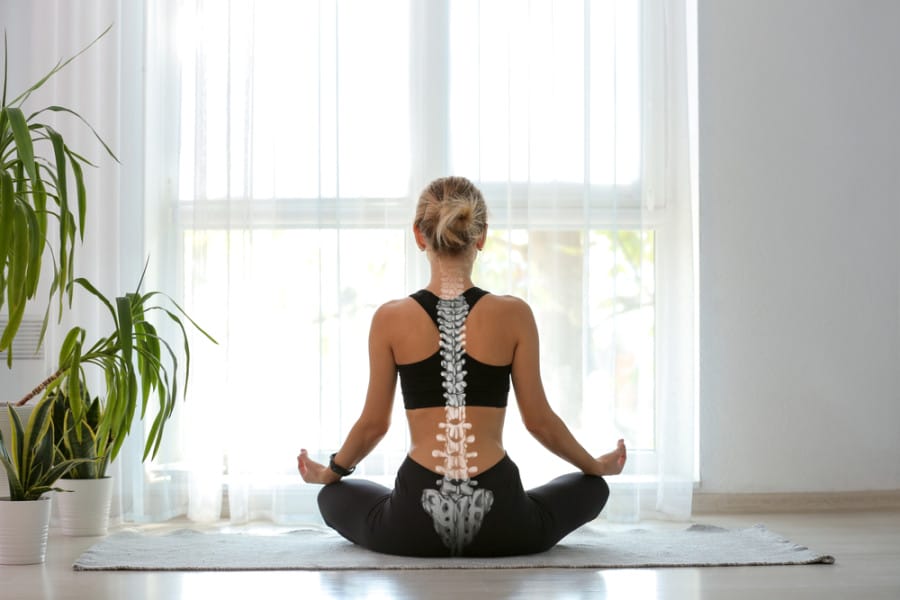Top 10 Steps For Good Posture
Now, why exactly is that? Well, good posture doesn’t just impact how you feel physically; it also does wonders for your mental state. Poor posture, on the other hand, can increase the stress on your spine by up to 300%, leading to many musculoskeletal issues and overall feelings of low self-esteem and reduced confidence.
Assess Your Current Posture
Begin by self-evaluating your posture to identify areas that need improvement. Stand relaxed in front of a mirror and observe your stance. If it’s challenging to assess on your own, consulting a physiotherapist for a professional evaluation is a wise choice. Common posture issues include a forward head, rounded shoulders, swayback, and slouching.
Creating A Posture-Friendly Space
Maintaining good posture is crucial throughout the day, especially in a workspace where people spend a significant amount of time. An ergonomic workspace not only promotes comfort but also reduces the risk of musculoskeletal issues and enhances productivity.
Having an Ergonomic Workspace means having an ergonomic setup so you’ll ensure proper alignment of the body, and reduce stress on the spine, shoulders, and neck. So make sure it’s comfortable for you by ensuring your chair and desk are set up correctly.
Here are some practical tips for an ergonomic desk and chair:
Chair Setup
– Adjust the chair height so that your feet rest flat on the floor and your knees are at a 90-degree angle.
– Ensure the chair provides adequate lumbar support to maintain the natural curve of your lower back.
– Armrests, if available, should allow your arms to rest comfortably and your shoulders to relax.
Desk Setup
– Position your desk at a height that allows your arms to rest comfortably while typing, keeping your elbows at a 90-degree angle.
– Use a monitor at eye level to prevent neck strain. If needed, use a monitor stand or adjust the screen height to align with your natural gaze.
– Keep frequently used items within arm’s reach to avoid excessive reaching or twisting.
Extra Friendly Tips
– Take regular breaks to stand, stretch, and walk a bit.
– Consider using ergonomic accessories like a footrest or an ergonomic keyboard and mouse to further maximize body comfort and alignment.
Incorporating Stretching Into Your Routine
Stretching is vital for improving and maintaining good posture by enhancing flexibility, relieving muscle tension, and promoting proper alignment.
Dynamic vs. Static Stretching for Posture Improvement
Dynamic Stretching
Characteristics – Dynamic stretches involve continuous movement through a full range of motion, usually resembling movements used in daily activities or exercise.
Benefits – Ideal as a warm-up before physical activity, dynamic stretching increases blood flow, improves muscle performance, and prepares the body for movement.
Static Stretching
Characteristics – Static stretches involve holding a single position for an extended period, usually around 20-30 seconds.
Benefits – Effective for relaxing muscles, increasing flexibility, and improving muscle length.
Core Strengthening Exercises
Strengthening core muscles is key to maintaining good posture. When these muscles are strong, they help maintain proper alignment, reducing strain on the back and enhancing overall posture. So which exactly are these muscles?
1. Rectus Abdominis – This muscle, often referred to as the “six-pack,” supports the spine and helps in maintaining an upright position.
2. Obliques – The internal and external obliques aid in twisting and rotating the trunk, contributing to overall core stability and posture.
3. Transverse Abdominis – Acting like a natural corset, the transverse abdominis provides stability to the spine and pelvis, crucial for cross-movements without injuring the spine.
4. Erector Spinae – These muscles run along the spine and help in maintaining an upright posture and supporting the back.
There are some effective core exercises you can easily do without any additional gear such as: Plank, Russian twists, Deadbug, or Bird Dog.
Select The Right Shoes = A Crucial Step For Posture Correction
Shoes form the foundation for body movement, and selecting the right ones is crucial for maintaining proper alignment. Ill-fitting or unsupportive footwear can affect your alignment, causing postural issues and discomfort.
Look for shoes that provide adequate support and cushioning to help maintain proper alignment of your feet, ankles, and legs. Properly cushioned shoes absorb impact while walking or standing, reducing stress on the joints and spine, which can impact posture.
So how do you choose shoes that support your posture?
– Look for shoes with good arch support that match the natural curvature of your feet. This helps distribute weight evenly, preventing overpronation or supination.
– Opt for shoes with adequate cushioning, especially in the heel and forefoot areas. This cushioning helps absorb shock and reduces stress on the spine.
– Ensure your shoes fit well without being too tight. Shoes that are too tight can restrict movement and circulation. However, shoes that are too loose can affect stability.
– Ditch excessively high heels or completely flat shoes. Instead, choose footwear with a moderate heel height that supports the natural alignment of the body.
– Choose shoes made from breathable and flexible materials that allow for natural movement while providing support.
– Regularly assess and replace shoes that show signs of wear and tear, as worn-out shoes lose their supportive features.
Arch Support And Foot Alignment
As I mentioned before, arch support is essential for maintaining healthy feet and it directly impacts overall posture and body mechanics. Adequate support for the arches helps distribute weight evenly across the feet, reducing strain on the ankles, knees, hips, and spine.
So, how can you make sure that your arches are properly supported when you don’t want to spend a fortune investing in multiple pairs of shoes with built-in arch support? A practical solution is to consider using good-quality insoles that are designed specifically to provide arch support andInsoles can have a subtle yet impactful effect on your overall posture.
How mindful are you in your daily life? Are you aware of how you’re holding your body and the effects your emotions and thoughts can have on your stance? Mindfulness techniques foster a deeper mind-body connection, enhancing body awareness and promoting intentional movement. Practices like yoga and tai chi can effectively integrate mindfulness with physical movements. Gaining body and breath awareness and improving mind-body connection can give you more control of your body and a different perception of it.
Nutrition plays a key role in maintaining good posture by supporting bone and muscle health and affecting inflammation, which can impact posture. Vitamins like Calcium and Vitamin D are essential for bone health, bone density, and strength, while protein promotes muscle growth and repair.
Proper hydration is crucial for joint lubrication and muscle function. Dehydration can affect muscle elasticity and joint mobility, potentially impacting posture by causing discomfort and reducing the body’s ability to maintain good alignment.
Here are some tips for better health through nutrition:
– Include Calcium-Rich Foods – Dairy products and leafy greens can provide the calcium necessary for bone health.
– Vitamin D Sources – Sun exposure, fatty fish, and egg yolks can help maintain adequate vitamin D levels.
– Healthy Fats – Choose foods like avocados, nuts, seeds, and fatty fish to support overall health and potentially reduce inflammation.
– Hydration – Ensure adequate water intake throughout the day. Aim for at least 8 glasses (64 ounces) of water daily.
Your posture won’t improve through solitary efforts. It is important to make taking care of your posture a habit. Here are some daily posture-friendly habits to consider:
– Mindful Sitting – Be aware of your spine while sitting. Use a supportive chair and keep your feet flat on the floor.
– Regular Breaks – Take short breaks every 30-60 minutes to stand, stretch, and readjust posture.
– Ergonomic Workspace – Arrange your desk, chair, and computer setup ergonomically to support good posture.
– Engage Core Muscles – Strengthen your core through exercises like planks or abdominal bracing to support better posture.
– Proper Footwear – Wear supportive shoes that provide adequate arch support and cushioning.
– Mindful Movement – Incorporate activities like yoga, Pilates, or Tai Chi to improve body awareness and posture, and more.
Be mindful of posture throughout the day, whether walking, standing, or sitting. By integrating these habits into your daily routine, you can gradually improve your posture and prevent related discomfort or issues.
Be aware of signs that indicate it’s time to seek professional advice for posture-related concerns. Here are scenarios that warrant consultation with a specialist:
– Persistent Pain
– Limited Mobility
– Posture-Related Issues
– Recent Injury
– Numbness or Tingling
You can consult either a chiropractor, physical therapist, or orthopedic doctor, based on your preference. Seeking professional advice at the right time can prevent further complications and aid in developing a personalized plan to address posture concerns effectively. Consulting specialists ensures a comprehensive evaluation and appropriate interventions tailored to your specific needs.
















